|
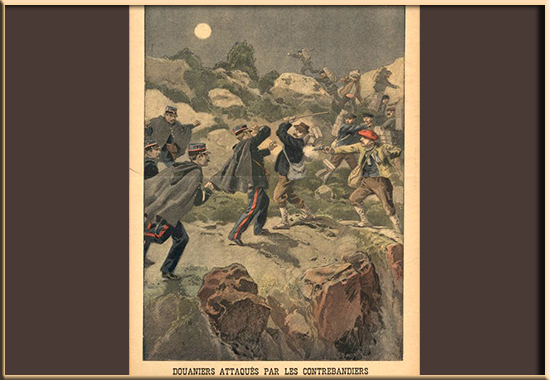
Customs Officials Attacked by
Smugglers
Taxation in Pre-Revolutionary
France
Between 1500 and 1789, France
was the leading power in Europe, dethroning Spain, making
Austria the runner-up, and preceding Britain.
|
|
However . . .
Image Above
Douaniers attaqués
par les contrebandiers
Customs officials
attacked by smugglers.
Le Petit Journal,
end of 19th century, which makes it
post-revolutionary, of course.
Musée National des Douanes |
. . . the country's revenues were based on a very complex system
of taxation.
Carried over from olden times, each province had different tax agreements with the
Crown. The resulting difference in tax rates from province to
province made it necessary to set up internal customs barriers
and was of course both, a challenge and a delight for
smugglers.
As it turned out, this unequal system of taxation
served as major fuel for the 1789
 French Revolution. French Revolution.
How so?
What Is the
Direct Connection Between Taxation in Pre-Revolutionary
France and the French Revolution of 1789?
It was the King's deficit that
caused him to desperately call for the
 Estates General on
August 8, 1788 — a deficit that could have been taken
care of and balanced out by
tax revenue. Estates General on
August 8, 1788 — a deficit that could have been taken
care of and balanced out by
tax revenue.
But there is more.
Taxes under the ancient
regime were based on privileges. Toward the end of the
ancient regime, two things became apparent:
1
A system based on privileges was felt to be
unjust.
2
A system based on privileges was almost
impossible to reform effectively because it
meant to cut the wings of the privileged,
whose power was given to them by this very
system.
Thus, in a nutshell, taxation in
pre-revolutionary France illustrated the injustice and the
impracticality of the actual cornerstone of French
society at the time — privileges.
And by illustrating its
inability to change, it demonstrated the
need for a major overhaul of the social order in France.
Regarding financial reform see also
 Calonne,
Calonne,
 Necker, and
Necker, and
 Turgot.
Turgot.
Go here for a
complete list of
 French finance ministers
under the ancien regime.
French finance ministers
under the ancien regime.
Let's dive in:
Currency
French currency was the livre,
a silver coin worth 20 sols or sous. One
sou was worth 12 deniers.
The louis, or louis d'or,
was a gold coin. It was minted as a half-louis, and as a 2, 4,
8, and 10 louis coin. One louis was worth 24
livres.
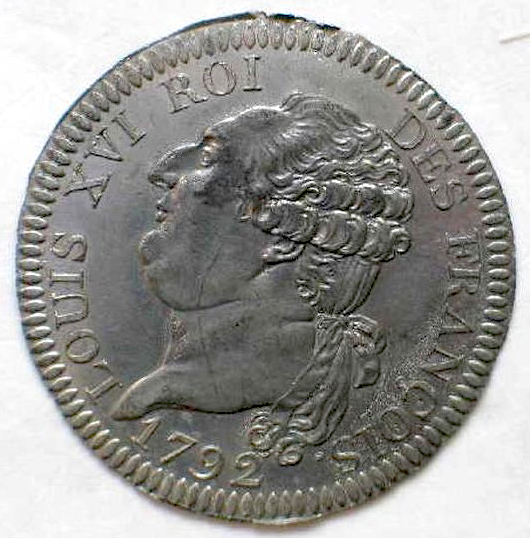
Obverse of a 3
livres coin with Louis XVI
sporting a bare neck somewhat invitingly
(Image
obviously enlarged, original is 3.5 cm or 1.37 inch in diameter)
Musée d'art et
d'industrie de Saint-Étienne
Tax Exemption
Nobility and clergy were exempt
from the largest direct tax, the
 taille. Most nobles
were also exempt from the
taille. Most nobles
were also exempt from the
 vingtième and
enjoyed preferred handling with regards to the
vingtième and
enjoyed preferred handling with regards to the
 capitation tax. The
last two taxes were also easy on the clergy by allowing them
to pay a lump sum, the don gratuit, as opposed to
taxing them individually.
capitation tax. The
last two taxes were also easy on the clergy by allowing them
to pay a lump sum, the don gratuit, as opposed to
taxing them individually.
If you had the money, you could
purchase certain offices that came with ennoblement and tax
privileges.
Tax Collection
France imposed direct and
indirect taxes.
Direct taxes were collected by royal tax
officials. At the end of the
 ancient regime, almost all
indirect taxes had been outsourced to collection agencies,
either via a 6-year lease to the ferme générale (General
Tax Farm) or to a régie générale.
ancient regime, almost all
indirect taxes had been outsourced to collection agencies,
either via a 6-year lease to the ferme générale (General
Tax Farm) or to a régie générale.
The main difference between the
ferme générale and the régie générale was that
the régie was a syndicate who received a fixed salary and
the risk of revenue fluctuation remained with the Crown. The
ferme
had to pay their annual flat fee no matter how the
economy was doing. On the other hand, the
ferme had lots of leeway and could make a
sweet profit.
Members of the ferme générale
were called fermiers-généraux, or farmers-general.
Members of the régie générale were called
régisseurs.
Farmers General
(Ferme Générale)
The Ferme Générale
(Farmers General or General Tax Farm) was created in 1681 by the famous
Jean-Baptiste Colbert, who lived 1619-1683, and was the
 contrôleur Général des Finances under contrôleur Général des Finances under
 Louis XIV. Louis XIV.
Colbert sold the right to
collect the royal taxes, i.e. the aide, traite, and
gabelle, for an annual sum
of 56 million livres. Colbert had a say in this
institution and kept
control of it. Later ministers didn't.
In 1747, the tabac was
added to the deal.
The ferme generale became an impressive institution. Five large
fermes generales joined forces
and employed nearly 700 people at their headquarters in
Paris.
After the army, the Farmers General
was the second
largest employer in the country, bringing in more than half of the government's revenue (see pie
chart).
They operated up to 42 branches in the provinces,
which, in turn, kept nearly
25,000 agents across the country busy. These agents were either occupied with
collecting and processing the money or they were fighting smugglers.
::
What were their powers?
To enforce collection, the
farmes generales could seize property. Their
gardes were armed and uniformed. Part of that uniform
was a little shoulder strap
that identified them as acting on behalf of the King. They
enjoyed special privileges and protection of the law. And a
reputation of being very corrupt.
:: How did they make
a profit?
By collecting whatever they owed on their lease, plus profit.
Highest revenue came from
the
 gabelle, the salt tax.
Unfortunately, the farmers generals
could arbitrarily collect whatever whenever wherever. This
did not happen all the time but there was little one could
do if it did. On top of that they
made you purchase a certain amount of salt, which of course
had a tax on it.
gabelle, the salt tax.
Unfortunately, the farmers generals
could arbitrarily collect whatever whenever wherever. This
did not happen all the time but there was little one could
do if it did. On top of that they
made you purchase a certain amount of salt, which of course
had a tax on it.
Furthermore, it spoke for itself when these people
arrived suddenly at immense fortunes.
Unpopular for obvious reasons, the Farmers General was
abolished in 1791. The entire institution was nationalized and reduced
to 15,000 agents. Internal customs barriers and the salt tax
were eliminated.
In November 1793, the
 Convention
ordered the arrest of all former members of the Ferme
Générale. Many fled. The rest was
Convention
ordered the arrest of all former members of the Ferme
Générale. Many fled. The rest was
 guillotined, among them the chemist
Antoine Laurent de Lavoisier.
guillotined, among them the chemist
Antoine Laurent de Lavoisier.
Back to 1780.
French Budget 1780
Here is French Revenues and
Expenditures around 1780. Population estimated at around 25
million. France had neither
a state bank nor a stock exchange.
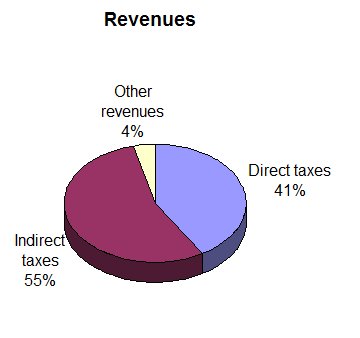
France 1780 Total Revenues
— 585 million livres

France 1780 Total
Expenditure — 610 million livres
Deficit: 25
million livres
Based on Cambridge Economic History of Europe, vol. 8, page
370, in turn draws from A. Wagner (1910), pp. 176f.;
and Marion, Histoire, vol. 1 (1914), Appendix, and
Necker's estimates.
Interesting things about these
pies:
Revenues:
-
Odd thing about revenues: nearly
nothing from public lands. In 1773, it was 6.4 million
livres, which was 1.6 % of total revenue. This meant that
the main revenue had to come in via the
other taxes. Meaning, taxation was hard on
the folks that didn't have land. This was contributing to
the resentment that exploded in the Revolution of 1789.
Expenditures:
-
Debt payment
made 43% of the expenditures in 1780. It
climbed up to 50.5% in 1788.
-
Military: 25%, which means a
little bit more than administration (21%). Compared to
Britain and Prussia, France spent much less
on military, but much more on admin.
-
Court: 6% (34 million
livres) was very
high compared with the only other court in Europe that was
able to compete, the court at Vienna.
Taxes in Proportion
Here is
Revenues in more detail to illustrate tax proportions:

Taxes in Proportion
France 1780 Total Revenues — 585 million livres
The Taxes in
Short
Different taxes were collected
by different agencies at different times. The situation at
the end of the
 ancient régime was as follows:
ancient régime was as follows:
Direct Tax
|
Indirect Tax
|
Collected directly by royal
officials:
Taille
Capitation
Vingtième
|
Collected by the ferme générale:
Gabelle
Tabac
|
| |
Collected by the régie générale:
Aide
Domaine
Traite
|
The Taxes in
Detail
Taille
(Property and Income Tax)
The taille was
an ancient tax,
established in 1445, originally paid to a lord in exchange for his
protection. Hence, clergy and nobility were
exempt.
This was a direct tax on the
property and income of the unprivileged
classes, collected by
royal officials.
 Louis XVI
split the taille into taille personnelle
(property / revenue / personal tax) and
taille réelle
(land and house property or household,
applicable in Languedoc,
Provence, Guyenne, Dauphiné).
Louis XVI
split the taille into taille personnelle
(property / revenue / personal tax) and
taille réelle
(land and house property or household,
applicable in Languedoc,
Provence, Guyenne, Dauphiné).
The taille was abolished with
the Revolution.
Capitation (Head Tax)
The capitation was
established in 1695 by
 Phélypeaux de
Pontchartrain, originally levied to
pay war expenses. It was a direct tax,
poll tax, on everyone and collected directly by royal officials.
Phélypeaux de
Pontchartrain, originally levied to
pay war expenses. It was a direct tax,
poll tax, on everyone and collected directly by royal officials.
The clergy
paid an annual fee, the don gratuit.
And
that was that.
The nobility, civil servants,
and privileged citizens paid
anything from 20 sous to 2,000 livres, depending on rank,
status, occupation, and property, which put
them in one of the 22 different tax classes.
Vingtième
(Income Tax)
The vingtieme was a direct tax
on everyone,
5 percent on income, collected by
royal officials.
Vingtieme
means one twentieth, which was the standard
rate in 1749.
Clergy, again,
paid the don gratuit (lump sum) and were off the hook.
But also provinces and
cities could do that, meaning in effect that
nobles and officials were usually exempt
from the vingtieme.
The vingtieme was established in May 1749 (Edit
de Marly) by
 Machault d'Arnouville. Machault d'Arnouville.
In 1756, a
second vingtieme was created by
 Peyrenc de Moras.
Peyrenc de Moras.
In 1760,
 Bertin created a third
vingtieme.
Bertin created a third
vingtieme.
In 1786, the
vingtieme was abolished.
Gabelle
(Salt Tax)
The gabelle
was an indirect
tax, a salt tax, on everyone, collected by the ferme générale.
Back in the
days, the gabelle was a tax not only
on salt but on various goods. In 1360, it
became a permanent tax.
It was abolished in March 1790.
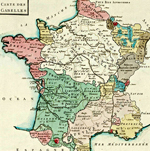
France 1781 - Gabelle
Tabac (tobacco)
Tabac was an indirect
tax, formerly a state monopoly, later collected by
the ferme générale.
Aides (Consumption Tax)
Indirect tax,
a consumption or excise tax.
In the Middle
Ages, the aides had to be paid by a
vassal to his lord and were due in four
cases: payment of a ransom if the lord had
been taken prisoner, the knighting of his
eldest son, the marriage of his eldest
daughter, departure on crusade.
The aides
transformed from an exceptional tax to a
regular tax levied on consumer goods, such
as wine, liquor, oil, textiles, tallow, iron,
wood, livestock, playing cards, hides, soap, paper etc.
Thus it became an indirect
tax on everyone. The aides were collected by
the régie générale. Collection was
complex and very tricky due to the regional
inequalities. It even required the creation
of a court, or board of excise
(Cour
des Aides) and a team of
inspectors, brokers, appraisers and so on.
The aides
were abolished with the Revolution.
Domaine
The
domaines were taxes on the royal domain,
the crown lands, collected by
the régie générale.
Keeping an eye
on everything that concerned the lands owned
by the crown was the
Chambre des
Comptes, or
Chamber of Accounts.
Traite (Customs Duty)
Traites
were
collected by the régie générale.
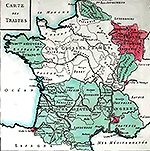
France 1781 - Traites
Timbre (Stamp Tax)
The timbre was
an indirect tax on legal transactions, collected by
the régie générale.
Octroi
(Local Customs)
The octrois were
indirect taxes on goods that were
brought into towns (customs).
Corvée
Not a tax per
se but compulsory labor
service on the peasants.
See also
 Corvee.
Corvee.
Tithes
Annual fee paid to
churches
by
landowners.
Smuggling
An absurdly
complex system of taxation naturally provoked
smuggling on an enormous scale. Consequently,
the fight against smugglers cost an enormous
amount of money and required an enormous amount
of manpower.
In 1784,
construction begun in Paris on a continuous
stone wall, known as Mur des Fermiers
Généraux, or
Wall of
the Farmers-General, marking the city
limits at the time. The wall was finished in
1787. It was higher than 3 meters / 10 feet and
23 km / 14 miles long, and its gates were
guarded by tax officials.
This particular
wall was built to limit the evasion of the
 octrois.
But the smugglers found their ways around it,
and the wall became a perfect target for the
citizens' wrath. The prices for food were
climbing while the greed of tax collectors were
as widespread as they were well known. A saying
by some unknown author became very popular
during these days:
octrois.
But the smugglers found their ways around it,
and the wall became a perfect target for the
citizens' wrath. The prices for food were
climbing while the greed of tax collectors were
as widespread as they were well known. A saying
by some unknown author became very popular
during these days:
Le
mur murant Paris rend Paris murmurant
It's not snappy at
all after translation, but in other words, The
wall walling Paris renders Paris murmuring.
Or maybe, The wall walling Paris makes Paris
wail.
And talking about
things that snap. On the night of July 12/13,
1789, the citizens of Paris burned 40 tax barriers and
ransacked tax offices.
Today we know, they were just
warming up for the
 bastille. bastille.
More About the
French Financial Administration Under the Ancien Regime
Here is Necker's
Compte rendu, 1781,
in French and English:
 Compte rendu au roi
Compte rendu au roi
 Report to the King
Report to the King
More History
|